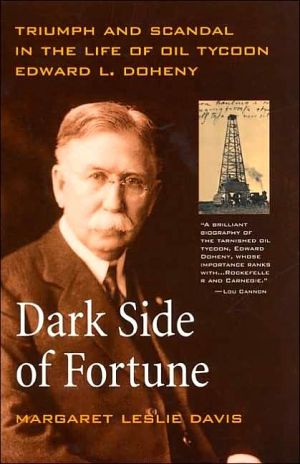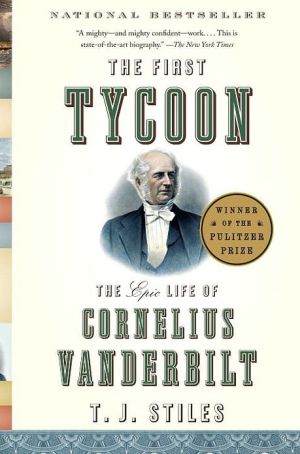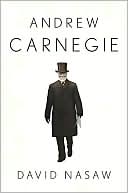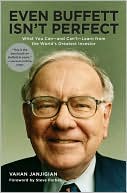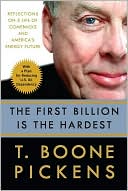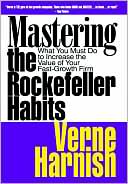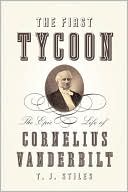Dark Side of Fortune: Triumph and Scandal in the Life of Oil Tycoon Edward L. Doheny
Margaret Leslie Davis's biography follows Edward L. Doheny from his days as an itinerant prospector in the rugged western territories into the jungles of Mexico, where he built an oil empire that helped inaugurate a new era of petroleum. But it was a tale that ended in tragedy when - at the peak of his power and prestige - Doheny became embroiled in the notorious Teapot Dome scandal and was charged with bribing the U.S. secretary of the interior. As accusations mounted, two special...
Search in google:
"Dark Side of Fortune is a brilliant biography of the tarnished oil tycoon, Edward Doheny, whose importance as an American industrial pioneer ranks with such better-known figures as Rockefeller and Carnegie. Margaret Leslie Davis has written a superbly researched and definitive account of the founder of the modern petroleum industry in California and of his machinations in Mexico and the involvement in the notorious Teapot Dome scandal. Davis has a sympathetic understanding of Doheny but tells his story warts and all. He emerges from the compelling biography as a conflicted man who is at once a hero and a scoundrel—and above all an American original who seems larger than life."—Lou Cannon"The life of Edward L. Doheny offers a fascinating saga of early twentieth century American triumph and tragedy. Dark Side of Fortune, based on significant new archival discoveries, resurrects Doheny in a sympathetic, yet not uncritical, and always readable, biography, shedding new light on the oil industry, U.S. relations with Mexico, and the political scandals of the 1920s."—Jules Tygiel, San Francisco State University"In terms of family saga, the Doheny story is the Ariadne's thread of Los Angeles history. It is perhaps the best pathway both into—and out of!—the labyrinth of the founding era. Thanks to Margaret Davis's Dark Side of Fortune, the full story of this previously mysterious Los Angeles Founder, his determined wife, and their murdered son stands revealed in all its resonant complexity. Ours is rapidly becoming a golden era of California biography, and here (once again, UC Press!) is further proof."—Dr. Kevin Starr, State Librarian of California"Margaret Davis' Dark Side of Fortune is pure California gold, a biography laced with adventure and misadventure, a carefully researched history that reads like today's investigative reporting, a briskly told tale rife with international hugger-mugger and domestic hanky-panky. And best of all, it just might rewrite the story of that White House horror of another year, the Teapot Dome scandal."—Ed Cray, University of Southern California; author of Chief Justice: A Biography of Earl Warren"Once again, Margaret Davis has demonstrated that she is a gifted writer and that truth is more fascinating than fiction."—Burt Kennedy, Brigade Productions"Behind Doheny's brash self-confidence and his mighty oil empire lurks the image of la calavera, like a skeleton in the closet. Death would undo many—from Doheny's murdered son to the fallen reputation of Harding's administration after the Teapot Dome scandal. This dramatic and historical tale reads like a novel. Davis has once again revealed a vital part of Los Angeles history and its national implications."—Noel Riley Fitch, author of Appetite for Life: The Biography of Julia Child John Flesher [Davis'] objective portrayal lends credibility to a fascinating narrative that will enrich the historical record while appealing to casual readers who enjoy tales of wealth, fame and political intrigue. -- ForeWord Magazine
Dark Side of Fortune\ Triumph and Scandal in the Life of Oil Tycoon Edward L. Doheny \ \ By Margaret Leslie Davis \ University of California Press\ Copyright © 2001 Margaret Leslie Davis\ All right reserved.\ ISBN: 9780520229099 \ \ \ One—\ The Young Prospector Doheny \ In later years, praising the rugged origins of Edward Doheny, by then a wealthy oilman far from his frontier days, publisher B.C. ("Bertie") Forbes claimed the young Doheny preferred outdoor life to indoor comforts: "Rarely did prospector Doheny sleep under other ceiling than the wide heavens. Each night he lay down with his faithful rifle at his side, his six-shooter ready for action and his hunter's knife at his belt."1\ The romanticizing of Doheny's mining days was more than the usual workings of nostalgia; it was a rewriting done by expert publicists and lawyers to humanize a millionaire under suspicion of high-handed dealing and to shift the focus to his early years as a stalwart frontiersman. Although there was no lack of colorful adventures to attribute to the young Doheny, later versions of his life omitted important details and enlarged or fabricated exploits. Such rewriting was abetted by the tendency in the mining camps to prize a tall tale over accuracy. In the saloons, western etiquette was observed and men were rarely asked to reveal much about their past. Some had reached the territories aheadof the law, and others had abandoned stolid pursuits as draymen or dry goods salesmen to try their luck at mining. Some had left farms and some had kicked over the traces of married life for adventure in the West. Some were sons from established families who wanted to prove themselves; others had cut all family ties.\ What is known of Doheny is that he arrived in the New Mexico Territory, barely twenty years old, hell-bent, like so many others, to make his fortune in mining. It was a tumultuous life in the 1880s, a long way from the seats of government and the niceties of society. Kingston, a mining town in New Mexico's Black Range mountains, was not the sylvan camp described by Forbes and the adventure magazines of the day. Prospectors lived a rough and vicious life among men of diverse, and often violent, backgrounds. The displaced and angry Apaches rode out of the hills and down through the canyons and streambeds in surprise attacks. Mining was a hazardous occupation.\ Doheny arrived in Kingston driven to succeed. His vision was always "just over the passes," as he trekked into ever more rugged territory. Born on August 10, 1856, in Fond du Lac, Wisconsin, he was the son of an impoverished Irishman who had fled from Tipperary to escape the Great Famine. Passage across the Atlantic had been brutal, and of four brothers only Doheny's father, Patrick, and one uncle, William, survived the journey to reach Canada.\ Patrick became a whaler, sailing the icy and treacherous waters of Labrador, where he eked a meager though adventurous livelihood. He gave up the seas when he met Eleanor Elizabeth Quigley. The two courted, married, and had five children.2\ By all accounts, Edward was a bright, earnest child. He studied hard and graduated from high school in 1872, valedictorian at age fifteen. He had an early grasp of mathematics and an excellent memory—as noted by the local newspaper, he "excelled at mental arithmetic."3 During the summer months he worked in the fields or at the town's sawmill. Times were hard and immigrant families were resented by the townspeople. The Irish newcomers were held in particular contempt by rural Protestants, whohired them as farm laborers but despaired for their Catholic souls and feared their "Popish" intentions.\ Edward's mother had hoped that her son would study for the priesthood. She was a woman of strict principles, who prided herself on thrift and simplicity. His no-nonsense father, who worked as a laborer and gardener,4 taught him from the start that anything worth having must be earned. Edward was forced to grow up quickly; just months after his graduation, his father died suddenly at age sixty-three.\ Edward took a job with the U.S. Geological Survey Department; still a teenager, he traveled to the Southwest surveying boundaries. Much of the time he rode with government mule buyers, who were trading with the local tribes. In the rough outdoor life he depended more on his wits than on physical strength. He was of slight build, weighing only 125 pounds; at his full height, he would be five foot seven. With reddish-brown hair, light skin, and blue eyes, he possessed the course and unrefined manner of a farm youth. He was described at this time as pale and rosy, as if he were constantly blushing, but he was already ambitious and fiercely independent.5\ The story is told that Edward soon embarked on his first entrepreneurial venture, purchasing ninety-two horses at a government auction for $5.35 each. After breaking and training the horses, he then sold them, pocketing a $2,000 profit. He continued to buy and sell horses and perfected his skill at driving a bargain.\ In 1873 Edward was sent to Kansas to assist in subdividing the Kiowa-Comanche reservation lands. The following year, barely eighteen years old, he quit his job with the Geological Survey to take up prospecting in the isolated regions of the West. He joined a gold-mining expedition—led by Charlie Quidero, a famous seeker of fortune—into the Black Hills of South Dakota. This adventure ended when U.S. government troops drove the miners out of the region for trespassing on the Blackfoot Sioux reservation. But the teenage Doheny had listened to the campfire stories of his older companions, and with his touted facility for "mental arithmetic," he calculated the riches from one good strike in the mines. With the zest and confidence of early manhood, he set out to claim his fortune.\ Doheny's travels took him to Arizona, which was then part of New Mexico Territory; but when the Arizona mines failed him, he collected hisbelongings and moved to Lake Valley, a site in the Black Range mountains rumored to be rich in silver. There his luck turned. He worked the "Iron King," a legendary mine that attracted droves of hopeful miners and gave the boomtown of Kingston its name.6 Doheny remained in the region from 1880 until 1883, living in a small adobe house. "Fifty dollars a year saw [me] through, with game plentiful and salt cheap," Doheny recalled.7\ The lands of the New Mexico Territory had been inhabited by indigenous people for hundreds of years, and the Navajos and Apaches believed a vitality emanated from the rugged peaks and deep canyons of the Black Range long before white men arrived to extract treasure from the mines. The tiny town of Kingston was scarcely a spot on the map—a half-day stagecoach ride from the nearest railroad. It was as remote as it could be from the financial centers of the East and the political life of the capital. Yet the town was to produce three men who would meld their youthful energy and friendship into common goals and strike out from Kingston to gain wealth and power that would shake eastern authority.\ At the poker tables of Kingston, Doheny would encounter the colorful Albert B. Fall, who was to gain fame as a western political boss and would later become a controversial secretary of the interior in President Harding's cabinet. Charles Adelbert Canfield, with a reputation as a hardworking, devoted family man, would enter Doheny's life as a fellow prospector and would later be Doheny's partner in multimillion-dollar undertakings. Unlike the scions of prominent families in the East who were attending universities, these sons of the West were getting a far different education, schooled by the fierce frontier. Later, their shared philosophy would create a far-reaching debate over the nation's resources, and reminiscences of their Kingston days would be offered and hotly debated. In future years, people in Kingston would speak of Edward Doheny, Charles Canfield, and Albert Fall as though boasting of giants.\ Lure of the Big Strike\ By May 1882, having made a firsthand study of mining operations, Doheny launched himself in the business. Mining required a constant infusion of capital—something young prospectors like Doheny lacked. Many times he had seen mining companions exhaust their resources in pursuit of the "big strike." Destitute and desperate, the unlucky miners were forced to sell their stakes at rock-bottom prices or walk away for want of a buyer with capital in hand. Putting his theory into action, Doheny and a prospecting partner developed claims on two mines in Lake Valley, the Phoenix and Old Reliable. When his partner faltered, Doheny scraped together cash to purchase his share for $150. It was not Doheny's plan, however, to work the mines. After retaining the claims about a year, Doheny sold them for a whopping $6,000.8 In total, Doheny's trade in mining claims earned him nearly $12,000 between July 1882 and 1883.9\ On the heels of that success, Doheny purchased the Mount Chief Mine. In 1885 he leased it to Charles Canfield. It was a fateful encounter, for the thirty-seven-year-old Canfield was to become Doheny's most trusted friend and would be involved in his rise to wealth.10 Canfield contracted with Doheny to work the mine with him, and as the two men labored side by side, they developed a hearty regard for one another, despite their very different temperaments. Canfield was restrained in his voice and movements, often seeming exhausted from chronic insomnia, and was slow to make a decision. Doheny was an energetic risk taker who fostered a Spartan indifference to pain and fatigue.\ Like Doheny, Canfield was a frustrated miner, desperate for a big strike. The former water pump salesman from Alma, Minnesota, had arrived in Kingston practically destitute after failing in mining expeditions to Chloride and other sites in the territory. Canfield was married, having wed former schoolteacher Chloe Phoebe Wescott, a striking dark-eyed brunette from Grand Island, Nebraska, in 1879. The couple began housekeeping in a small cabin near one of Canfield's mines at Ruby Hill, Nevada. Their first child, Florence, was born later that year. But after Canfield exhausted his financial resources, he was forced to send his wife and their infant daughter back to Grand Island to live with her parents. The distraught Canfield told one and all that he was determined to succeed for their sakes.\ Charles Canfield was of English-Scottish ancestry, born near Springville, New York. He was one of eight children. He had friendly, darkbrown eyes, a strong forehead, and a charming cleft in the middle of his chin. He sported a thick salt-and-pepper mustache. His Kingston companions described him as a serious man known for common sense and diligence and well regarded for honesty. Doheny's assertive nature was annoying to the more seasoned Canfield, eight years older, who attributed Doheny's self-importance to the zealousness of youth. While Canfield spent hours each evening writing long letters to his wife, Doheny remained uninterested in domestic affairs: his dreams were of the fortune he was sure destiny and hard work had in store for him.\ By the time Doheny and Canfield became mining partners in 1885, Canfield's daughter Florence was six years old and his son, Charles Orville, had celebrated his third birthday. Canfield had spent ten grueling years in the frontier camps, seldom seeing his family, and throwing all his energy into searching for the elusive strike. For the next year, he toiled in Doheny's mine. Chloe Canfield begged him in plaintive letters to abandon his mining efforts and return to Grand Island, but he was inflexible: "I am confident I can make money in this camp," he gently explained. "Only hold your grip a little longer to see how I come out, is the wish of your ever loving husband."11 But Canfield's assurances to his wife were not soon realized. Again and again he ran out of supplies and money. Nevertheless, his daily letters reflect not only the harsh conditions but also his firm resolution:\ It is snowing very hard tonight, about eight inches on the ground. The old tent is leaking like a sieve, our bedding is all wet and I am alone. . . . My chances to make some money here are first rate and I expect to be all right in the Spring.\ . . . I will make you and the children comfortable if I live. If you will keep up courage all will come right.12\ Although Doheny admired Canfield's dedication, he did not envy Canfield's position as a cash-strapped family man.\ Doheny had been a determined bachelor, believing he had little time and attention to devote to a woman. But in the spring of 1883, he was introduced to Carrie Louella Wilkins, an extroverted twenty-year-old who occasionally graced the stage in local musical productions. She was thedaughter of Mariah Brophy, one of the first pioneers to have settled in the Kingston area, said to have come "when the brush on Main Street was so thick that no person could ride through it."13 Mrs. Brophy, a widow, ran Kingston's boardinghouse, the Occidental Hotel, a two-story wood-frame structure along Main Street. Carrie Wilkins worked there with her mother.\ No reliable photograph exists of Carrie Wilkins, but she was described as an attractive brown-haired woman with hazel eyes and sun-tanned skin; neighbors knew her as strong-willed, with a mind of her own. She and Doheny were very much alike, which may account for both their attraction and later discord. Intrigued by Carrie's outgoing nature, Edward began to spend many evenings at the Occidental Hotel after his long days in the mine. Their courtship was short, and they were married on August 7, 1883, in Silver City, three days before Edward's twenty-seventh birthday. Following the wedding, the Dohenys took up residence with Mrs. Brophy at the Occidental.14 In December 1885, Carrie gave birth to a daughter, Eileen, who arrived safely but was very frail. A few months later, the Doheny family moved into a house of their own on the south side of Main Street.\ Carrie Doheny volunteered for the Ladies Episcopal Guild and continued to sing in Kingston's church choir. The Kingston Weekly Shaft described a hospital benefit at which "Mrs. Doheny took the large audience by storm in her charming song, 'The Wanderer's Return.'"15 Other news items of the time were less cheerful, revealing that she was struggling with increasingly serious health problems, forcing her to spend great amounts of time in isolation. Carrie Doheny's ailment remains a mystery, but its symptoms, as noted by others, were wild mood swings, bouts of depression, and paranoia.\ Rumors circulated that Carrie had begun to drink heavily. Miners and their wives speculated that the new Doheny union could not endure. At one point, a visibly shaken Edward Doheny confided to Johnny Moffitt, a mining companion, that a physician had ordered Carrie to travel to El Paso, Texas, for medical treatment but that he could not afford to send her there. Moffitt gave Doheny all the money he had in his pocket, saying, "Carrie is a good woman, even if she is a bit excitable, and she deserves help."16 Kingston was a rough place to raise a family. Coarse prospectors and drifters gambled, drank, and fought on the streets. Fist fights and knifings were common occurrences. The few miners' wives had to adopt very restricted lives; they attended church, made infrequent forays to purchase dry goods, and found little opportunity to socialize. They remained largely housebound.\ Carrie Doheny and Eileen often stayed with Carrie's mother at the Occidental Hotel; Edward continued to work at the mines and to spend his time with Charles Canfield and the other miners. His complexion had turned ruddy, brutalized by the wind and sun. He was usually seen in a hat, his blue-gray eyes bright in the shade of the brim. Though he was portly in later life, in these early years he hadn't much bulk to him and undoubtedly counted on quick thinking rather than strength to get him out of a scrape. He was a regular at the dance halls, variety shows, and saloons where workingmen would "lay their week's 'clean up' on the altar of chance" every Friday night.17 At the Main Street Saloon, Doheny gained a reputation as a veteran cardshark. His quick mathematical mind (and lifelong abhorrence of alcohol) gave him an edge in poker over his slower-witted acquaintances, who were often inebriated when they played. His winnings were welcome income.\ It was during this period that Edward Doheny met Albert Fall. Combative and boisterous, Fall also loved cards and was described as possessing the sort of piercing black eyes that indicated a "man who could take care of himself in almost any sort of company." He was tall and lean, with a bronze-toned complexion. He spoke with a soft drawl (more Kentuckian than Western), and he was rumored never to be without a gun—and to have been known to use it.18\ One tale that Fall enjoyed telling about their Kingston years made Fall an eyewitness to a brawl when Doheny was purportedly threatened and chased wildly by an enraged drunk. Doheny hot-headedly retaliated with gunfire: he nearly missed his target entirely but did manage to wound his attacker in the leg. Fall boasted that he was the first person to step up and congratulate Doheny on his "coolness under fire" and his skill with firearms that enabled him to send a bullet only to the leg.19 Such stories chronicled the beginnings of an interlocking friendship. Their pathswould continue to cross during the rowdy and dangerous days in the mining camps around Kingston and, much later, in the nation's capital. Their friendship over fifty years would coincide with the economic expansion of the country, a vibrant time that would assign them both important roles; but when the fortunes of Albert Fall turned dark, the consequences for Edward Doheny would be dramatic.\ Albert Bacon Fall was the son of William Ware Robertson Fall, a former captain in the Army of the Confederate States of America who became the editor and publisher of the Independent Democrat Newspaper in Las Cruces, New Mexico, during territorial days. As a child he had been ably home-schooled by his father; later he studied law in the office of Judge William Lindsley, who would become a U.S. senator. But young Fall did not take readily to the confining environment of a law office, and in the early 1880s, chronic illness forced him to find an occupation that would take him outdoors.20 Fall's biographer, Gordon Owen, describes Fall's ailments as "flu-like," including bronchitis and pleurisy. Fall spent time in Arkansas, the Oklahoma Territory, and Texas working as a cowboy and chuck wagon cook. At the age of twenty, he worked as a miner in Zacatecas Province, Mexico, where he became fluent in Spanish.\ His health improved, and Fall ventured north to Clarksville, Texas. There, he sold insurance and real estate, picked up law again, and in 1882 met Emma Garland Morgan. She was an orphan; her mother had died shortly after her birth, and her father, Simpson H. Morgan, president of the Memphis and El Paso Railroad, had recently died and left her a large estate (mostly in land and railroad stocks). Emma Morgan was a statuesque, handsome young woman and a ward of her uncle, Dr. Jack Morgan.\ Owen notes that in courting Emma, Albert "had serious hurdles to overcome. She already was engaged to a young Texan, and probably, constituting a more serious barrier, her uncle did not look favorably upon Albert Fall as a suitor. Albert recalled . . . Uncle Jack calling him an 'up-start and whippersnapper' and accusing him of being a 'fortune hunter."' When the two were married in Readyville, Texas, on May 8, 1883, it was agreed that Emma's funds would be placed in a special trust. With great fanfare, Fall signed a unique premarital contract pledging himself tomatch his wife's fortunes. He told his bride's family, "I'll have papers drawn up protecting her money form me[.] . . . [E]ven she [won't] have use of the money until I can equal it with what I earn."21\ Fall thought silver mining would be the quickest means to his goal. So it was that he arrived in Kingston not long after Doheny, joining hundreds of other eager young men in the mining camps who were digging for riches. Emma Fall remained in Clarksville, Texas, to care for their two infant children, Jack and Alexina.\ As times grew hard in Kingston, the steady drain on Edward Doheny's financial resources forced him to borrow money—not for investments or mining endeavors, but merely to buy food.22 These money problems strained the Doheny's already fragile marriage.\ Soon it was obvious that the Mount Chief Mine was not going to provide a bountiful haul of silver ore. Charles Canfield began to scour the countryside for other potentially lucrative sites, while continuing to toil at the maddeningly unproductive Mount Chief Mine. He feared that he faced another year of self-denial, labor without reward, and separation from his family. At the close of one more weary afternoon in late March 1886, Canfield discovered a steep trail that led high above a nearby mine, the Comstock (not to be confused with the famous Comstock Lode of Virginia City, Nevada), which was about a mile and a half west of Kingston. Alighting from his horse, Canfield surveyed the area, then rested briefly under a shade tree; he idly scratched the ground with a prospector's pick. Suddenly, he noticed what miners call "scattered float." His heart began to beat wildly, for he realized the shiny granules meant that he was sitting atop a very rich vein of silver ore. After returning to the site above the Comstock several times that week, Canfield concluded that the outcropping ore probably had its origins deep within the Comstock mine. He approached the Comstock's owners and requested a lease to the property. In exchange, Canfield told them he would give them a one-third interest in anything he discovered.23\ After securing the potentially valuable lease, Canfield took Doheny tovisit the property. Their first few forays into the mine proved far from auspicious. For weeks they labored without discovering significant quantities of ore. Eventually, Doheny became exasperated and stopped accompanying Canfield to the site, a decision he would later regret. Canfield continued to prospect at Comstock despite his dwindling finances and supplies. He was intent on finding a substantial vein. Within two months, he had done so: he struck an incredibly rich silver ore chamber, eighty feet long by twenty-five feet wide, larger than any that had been discovered in the region. Surprised prospectors told Canfield that he stood to earn as much as $1 million from his discovery.\ Doheny was astounded by his friend's remarkable luck and he was also greatly envious. He had prospected as long as Canfield had. But a strike akin to the "Great Canfield Bonanza"—as the country now called Canfield's discovery—had perversely eluded him.\ By May 22, 1886, Canfield was reaping $1,000 daily as he worked day and night in the mine, extracting silver ore. As the end of his six-month lease drew near, Canfield doubled his efforts. Soon he was maintaining an almost superhuman work pace. He grew so utterly exhausted that he collapsed from what miners called "brain fever."\ Chloe Canfield was summoned from Grand Island to Canfield's bedside, for she was told he was near death. His wife's arrival soothed the desperately ill miner and somehow Charles rallied, although he never fully recovered. For the rest of his life he would suffer frequently from debilitating headaches. The attractive young woman's calm and dignified presence invigorated the camp, and Canfield's crew labored harder than usual, undoubtedly for Chloe's benefit as well. A weakened Charles Canfield supervised dozens of workers in twelve-hour shifts as they extracted $10,000 a day in silver ore from the Comstock mine. By the time his lease expired, he had grossed nearly $390,000 from the sale of his silver ore. Canfield promptly paid the mine owners their royalties in cash and gave 50 percent of his own share to his partners and crew. Then, bidding farewell to Doheny and his acquaintances, he and his wife departed from Kingston, bound for California. In his possession was more than $112,000 in cash.24\ The absence of his close friend, the turbulent relationship with hiswife, and the suffocating poverty that entrapped him plunged Doheny into gloom. The stampede of fortune hunters who had come to town had succeeded in depleting the mines' once-abundant resources. Additionally, a nationwide glut of silver in the marketplace had depressed the price. Kingston was no longer a thriving boomtown but a sorry, poor man's mining camp.\ In July 1889, Doheny was forced to accept a job painting a pharmacy in nearby Hillsboro in order to feed his wife and daughter. This may have been the last straw. He packed his bags in disgust and moved his family to Silver City, New Mexico. The Kingston Weekly Shaft reported that "Mr. Doheny will study law under Mr. H. L. Pickett, a well-known lawyer for the district."25 It appears, however, that Doheny's plans changed in Silver City. There is no evidence that he was granted a license to practice law, despite his later claims to the contrary. We only know that four months after settling in the town, Doheny received a commission as a notary public and began to process mining claims and patents in an office he set up.26\ At first, Carrie Doheny tried to embrace her new home. She performed in a gala at the Silver City Opera House featuring local talent,27 but that was her last appearance on stage. News of her declining health was reported in the local newspapers, and by the fall of 1890, she became so ill that her mother, Mariah Brophy, rushed to Silver City several times to take care of her.28 That support was soon to become less available, for in early 1891 Carrie's mother married for the second time, wedding Martin Barber at a ceremony conducted at the Dohenys' Silver City home.29 Finally, in February, Edward escorted his wife to El Paso for treatment.\ The Golden State\ Doheny continued to work in the mines, again to no avail. Local newspapers dutifully reported his many partnerships—none of which reaped noteworthy profits. He decided to head farther west. Undoubtedly, one decisive factor was Carrie Doheny's continuing health problems. On March 6, 1891, the Silver City Enterprise reported that her health had improved and hinted at the couple's imminent departure. The nature ofCarrie's illness, however, still remained unmentioned: "Mrs. Edward Doheny, who has been quite ill and was taken to El Paso last week by her husband, is improving rapidly. The lady's general health was seriously affected by the altitude here. She will probably visit San Diego as soon as the washouts are repaired."\ Edward's decision to leave Silver City was also influenced by Charles Canfield's great success in California. Doheny had heard that Canfield had become a highly successful real estate speculator in Los Angeles and had purchased an enormous mansion in elite Westlake Park. The fever of land speculation was raging throughout the city; and thanks to the profits he had obtained from the Comstock mine, Canfield had been able to benefit from the excitement. His investments in real estate were substantial and widespread. To Charles, nothing was too good for Chloe and their children, and he spent his money quickly. His son-in-law later wrote of these years that "money went out with a more lavish hand than the little fortune warranted."30 Canfield also indulged his love of horses. After purchasing the well-known O.K. Stables in Los Angeles, he had thoroughbreds shipped to him from as far away as Nebraska and Minnesota. A four-year-old trotter named Billy was his particular favorite of the horses he proudly raced at popular matinee racing events throughout Southern California.\ But the land fever that had fed the great boom cooled and after a spectacular three years his fortune was swept clean away. The good life seemed over, as Canfield suddenly found himself worse off financially than ever before. This time he was not just flat broke, as he had been many times when he was working in the mines, but deeply in debt. Canfield was forced to liquidate nearly everything he owned—his stable and beloved horses were sold and his real estate holdings were "wiped out for a cruel loss." He was heartsick about the disaster now facing his family, and he vowed to win his fortune back. He took off to prospect in the Mojave Desert, and when that proved futile, he headed for San Diego, where he had leased a gold mine called the Ophir. "I am to blame for your coming to such a fix," Charles wrote Chloe. "I am doing all I possibly can to replace what justly belongs to you and the babies."31 Again Charles promised Chloe that he would return as soon as his fortunes had been restored.\ \ \ \ The news that the land boom had collapsed and that his friend was broke did not reach Doheny before his departure for California. On Doheny's arrival in Los Angeles in the winter of 1891, he was shocked to learn that Canfield had lost all of his extensive real estate holdings, except his residence, was deeply in debt and had left town to start anew. In an astonishing coincidence, while traveling through the district looking for work just weeks after arriving in California, Doheny spotted Canfield on a train platform in Victor (now called Victorville). He rushed from his rail-car and clasped his surprised friend. Canfield told Doheny about the Ophir mine. Doheny hastily abandoned his plans to return to Carrie Doheny and Eileen, who were waiting for him in Los Angeles; instead, he joined Canfield and hopped aboard the railcar bound for San Diego.32\ There the two men found lodging and formed the Pacific Gold and Silver Extracting Company. Despite their great efforts, the mythical big strike escaped them again. Months later, they admitted defeat and boarded a train for Los Angeles to return to their families, beaten and downcast, with only a handful of dollars in their pockets.\ \ \ \ \ \ \ Continues... \ \ \ \ Excerpted from Dark Side of Fortune by Margaret Leslie Davis Copyright © 2001 by Margaret Leslie Davis. Excerpted by permission.\ All rights reserved. No part of this excerpt may be reproduced or reprinted without permission in writing from the publisher.\ Excerpts are provided by Dial-A-Book Inc. solely for the personal use of visitors to this web site. \ \
List of IllustrationsixPreface: La CalaveraxiiiPrologue: September 11, 19351Part 1La Calavera Del Conquistador1.The Young Prospector Doheny72.Her Coldest Welcome213.Rivers of Black Gold344.Spoony Visits515.The Golden Lane616.Powered by Oil807.Millions Made Knowing How97Part 2La Calavera Del Comerciante8.Perfectly Legal1259.The $100,000 Bagatelle14010.Gaps in the Record16811.Scared Rich Man19912.The Last Appeal216Part 3La Calavera Del Final13.Night of Terror22914.A Broken and Changed Man24615.The Final Trial255Epilogue: La Calavera del Futuro283Notes289Bibliography315Index325
\ John Flesher[Davis'] objective portrayal lends credibility to a fascinating narrative that will enrich the historical record while appealing to casual readers who enjoy tales of wealth, fame and political intrigue. -- ForeWord Magazine\ \ \ \ \ Kirkus ReviewsCalifornia historian Davis (Rivers in the Desert: William Mulholland and the Inventing of Los Angeles, 1993) revisits Teapot Dome, the cause célèbre that began in the time of Warren Harding, to tell the story of one of the scandal's prominent actors, now largely forgotten. As the Gilded Age turned into the Jazz Age, Edward Doheny, hitherto a feckless prospector, peered into the La Brea tar pits and saw a fortune. He punched the first hole for oil in the city of Los Angeles. Successful, he turned to wildcat drilling in the jungles of Mexico. Gusher followed gusher and the shrewd Doheny became wonderfully rich, the master of a great mansion, a private railroad car, and all the accoutrements of great wealth. It was a world of puissant bigwigs, of powerful cronies, extravagantly mustachioed. It happened one day that the oilman transmitted $100,000 in cash to a cash-poor old crony, Albert Fall, who was then Harding's secretary of the interior. He called it a loan. Just about the same time, the Department of the Interior granted Doheny's company favorable leases in fields dedicated to naval oil reserves. Harry Sinclair, another oilman, obtained similar leases in a field known as Teapot Dome for its odd rock formation. When the deals came to light, a battle between conservationists and exploiters erupted. A Senate investigation turned the transactions into scandal, and civil and criminal trials followed. Fall took the Fifth, but was jailed anyway. Sinclair did time, too. Doheny, though, was found innocent of any criminality. His story and that of his family and friends is told expertly, though with a clearly sympathetic bias, while some questions remain (e.g., why was the"loan" made in cash?). Drawing on a new-found trove of Doheny's personal correspondence, and well researched and narrated, this revisionist biography is an interesting addition to the social history of the times. (50 b&w illustrations, not seen)\ \
